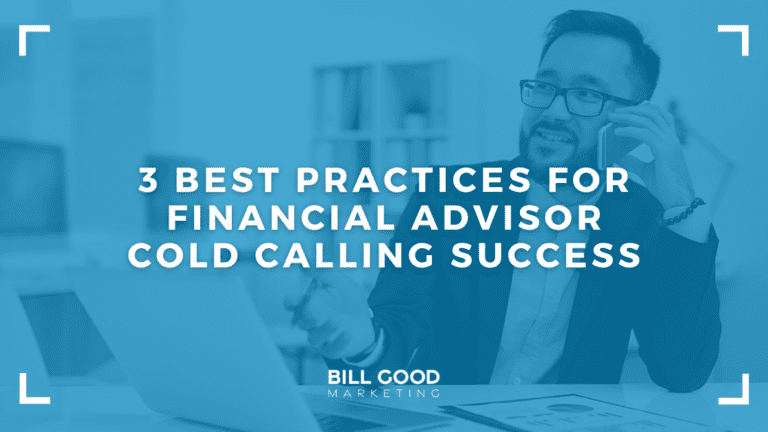Make no mistake, cold calling still works for financial advisors. It’s certainly trickier than it used to be, but if we rigorously apply the principles of what we modestly call the Good Way to Cold Call, you can still have outstanding success with this marketing channel.
For example, one financial advisor we coach raised $36M in new assets, mostly from cold calling. And this isn’t some grizzled veteran who has been cold calling since the 1980s. No, this financial advisor is in his early thirties! And he’s cold calling today.
The reason cold calling is still a viable channel for wealth management is because it remains one of the fastest, most direct ways to fill your pipeline with leads – again, if you do it right.
While seminar marketing is probably the king in this area, the big difference between seminars and cold calling is that seminars can be expensive. Cold calling isn’t.
Three Best Practices for Cold Calling the Good Way
We could write an entire book on cold calling scripts for financial advisors – and in fact, we have. But here are three key best practices to get you started.
1. Develop a targeted list and hone your sales pitch to fit that list.
This is known as targeting, or as we like to call it, precision cold calling. The principle behind it is simple. If you try to sell to everybody, you probably won’t sell to anybody.
But if you can identify a specific segment of your market, make that segment your core audience, and craft your value proposition to address that audience’s specific pain points, needs, hopes, and fears, you will become the dominant financial advisor for that audience.
Here are some examples, taken from actual financial advisors who are killing it with cold calling:
- List: Local or low-level corporate executives of publicly traded companies
Offer: A free report on their company stock, options, or restrictions - List: Local business owners aged 60 and up who may be looking to sell their business or retire
Offer: A guide on how to successfully transition their business - List: Working women who are recently divorced
Offer: A white paper on the most common tax mistakes divorcees make and how to avoid them
The point here is that you’re not just calling names in the phone book and offering a consultation. You are calling specific potential clients who are likely to have specific needs and offering information of immediate value that they can’t just get anywhere.
By the way, the fact that you’re offering information and not an appointment is critical. NEVER try to sell on the first call. “Prospecting” and “selling” are two entirely different activities.
It is a complete waste of your and the prospect’s time to try to sell anything on the first call.
Your objective is very simple: Find someone who is interested, qualified, and will talk to you.
Then, get to work building a relationship with them. Offer information they want, send it promptly, then call back in five to seven days. On the second call, you can ask more questions and try to set an appointment.
2. Pick the cherries, not the pits.
The old way to cold call was to treat all potential buyers as liars. It didn’t matter if someone said they weren’t interested – the cold caller’s job was to keep pestering them until they said yes.
Don’t do this.
First, it’s simply bad manners, and will quickly earn you a reputation as a nuisance and a disturber of the peace.
Second, it just doesn’t work. It takes too long and almost never leads anywhere.
Instead, follow the “Cherry Picker Principle.” If someone says, “I’m not interested,” all you have to do is say:
“Thankyouverymuch.”
That’s it. You can say it as one word if you want. Then hang up and move to the next prospect’s name on your list. You’re looking for people who are interested now. In short, you’re looking for the cherries, not the pits.
This principle is THE secret to making lots of phone calls. “Pit polishing,” as we call it, is a waste of time. You want to get in as many dials per hour as possible, so you can find as many cherries as possible.
What is a cherry, exactly?
Simple: A cherry is someone who is interested in whatever you’re offering, qualified to do business with you, and able to make a decision.
It’s simple. Focus on the pits and you’ll starve. Find more cherries, and you’ll never go hungry again. When someone isn’t interested, say “Thankyouverymuch” and move on. You’ll both be glad you did.
3. Treat cold calling as a numbers game and keep good stats.
Cold calling is a numbers game. Make more dials per hour and you’ll talk to more people. Talk to more people and you’ll find more cherries. Find more cherries and you’ll set more appointments. Set more appointments and you’ll close more prospects. Close more prospects and you’ll get more clients. You get the idea.
Ideally, you should shoot for 40-60 dials per hour.
If you combine that with a good lead generation list and a good cold-calling script, you should be able to find approximately 2-3 cherries per hour.
Assuming you call for, say, three hours per day, you could have 45 new promising leads in your pipeline every week. (And by the way, we’re not spit-balling these numbers. They are based on years of testing and observation.
Now, it may take a bit of time to achieve these stats, and you might need to tweak your methods along the way. For example, if you just can’t get up to 2-3 cherries per hour, consider changing your script. If that doesn’t work, you might need to try a different list. Be willing to experiment. Commit to the process and it will pay off.
To ensure you are hitting these numbers, though, be sure to keep good stats! Always write down:
- How many dials are made per hour
- How many contacts you make per hour (people who answered the phone)
- How many cherries you find
If one of your stats is off, make the necessary adjustments and get it within the ranges we’ve shared above.
Is Cold Calling Right for You?
Many financial advisors won’t even touch cold calling, and we understand that. It’s not for everyone. But it may be right for you if:
- You need to focus on filling your pipeline with leads.
- You don’t have much capital to spend on seminars, or enough existing relationships to leverage.
- You are just starting out in the financial services industry.
- You are patient, enjoy being on the phone, and are willing to tinker in order to find the perfect formula for you.
In our experience, if you like to fish, you can be a great cold caller.
Of course, cold calling may not be right for you if:
- You hate being on the phone or have a short attention span.
- You have poor phone skills and are unwilling to work on improving them.
- If you fear rejection. You will get a lot of rejections when you cold call. It’s just part of the game.
- You live in a very small market, where there simply aren’t enough prospect names to come up with a viable list.
How Bill Good Marketing Helps Financial Advisors Succeed with Cold Calling
Cold calling has been our bread and butter since the 1970s, and we still help clients find success with it today, partly through our exclusive client resources:
- Cold Calling Scripts for Financial Advisors: We have dozens of scripts covering a variety of offers, niches, and styles to help advisors find leads in almost any market.
- 401(k) Cold Calling Campaign: This campaign is designed specifically to help you target the 401(k) retirement plan market.
- Precision Cold Calling Kit: Every tool you need to succeed at cold calling business owners – one of the most lucrative markets around.
- Sales Training: Our comprehensive salesperson training includes cold calling tips and best practices to improve your success rate.
Additional Tips for Successful Cold Calling
- Leverage Social Media: Use platforms like LinkedIn to research your prospective clients and make your cold calling scripts more personalized.
- Follow-Up Calls: Always schedule follow-up calls and keep a record of your interactions. This shows professionalism, persistence, and ensures your calendar stays fully booked for the next week.
- Cold Emails: Complement your cold-calling efforts with cold emails. Sometimes an email can open the door for a successful phone call.
- Personal Connections: Use any personal connections such as alma mater, mutual business connections, etc. to make your introductions more effective.
- Webinars and Events: Invite prospects to webinars or other events. This provides value and positions you as an expert in financial planning and wealth management.
By implementing these cold-calling tips and integrating them into your sales process, you can improve your lead generation and ultimately grow your client base. Remember, cold calling is just one part of a comprehensive marketing strategy that includes telemarketing, social media, and other forms of outreach.
The Bottom Line
Cold calling can be a powerful tool for financial advisors if done correctly. With the right approach, scripts, templates, and persistence, you can turn cold calls into warm leads and new clients. Whether you’re targeting small business owners, retirees planning their financial goals, or prospective clients looking for specific financial products, cold calling remains a valuable part of the sales process. Keep honing your techniques, track your success stories, and stay committed to your cold-calling efforts to see a positive impact on your bottom line.
If you want help with cold calling or access to our different cold calling scripts and materials, contact us or give us a call at 888-495-7303.
About the Author

Andrew D. White is the Director of Marketing at Bill Good Marketing, a firm with over 45 years of experience helping financial advisors scale their businesses. With deep expertise in advisor marketing, client acquisition, and retention strategies, Andrew specializes in creating high-impact campaigns that drive measurable results. His insights are grounded in real-world experience, working alongside top-performing advisors to refine prospecting, branding, and practice management strategies.




